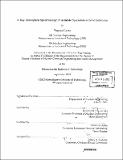| dc.contributor.advisor | Kenneth R. Czerwinski. | en_US |
| dc.contributor.author | Curran, Virginia, 1977- | en_US |
| dc.contributor.other | Massachusetts Institute of Technology. Dept. of Nuclear Engineering. | en_US |
| dc.date.accessioned | 2005-06-02T16:31:30Z | |
| dc.date.available | 2005-06-02T16:31:30Z | |
| dc.date.copyright | 2003 | en_US |
| dc.date.issued | 2003 | en_US |
| dc.identifier.uri | http://hdl.handle.net/1721.1/17642 | |
| dc.description | Thesis (Ph. D.)--Massachusetts Institute of Technology, Dept. of Nuclear Engineering, 2003. | en_US |
| dc.description | Includes bibliographical references. | en_US |
| dc.description.abstract | It is widely recognized that the behavior of actinides in the environment is dictated by their speciation, or chemical form. It is therefore imperative to have a clear understanding of a waste form or environmental contaminant in order to effectively assess and treat the affected area. Current methodology utilizes the distribution coefficient (Kd), a rough measure of contaminant mobility in environmental systems, however neither the empirical nor theoretical determination of Kd is well defined. Although we understand the limitation of the Kd parameter, the reality is that the Kd is often the only parameter used in environmental fate and transport models to account for the mobile fraction of contaminate in predicting total risk. A fresh approach to the problem incorporating speciation that can be applied to a wide range of conditions is required. X-ray absorption spectroscopy (XAS), a nondestructive technique that is ideal for determining the molecular composition of materials in dilute quantities in solution and solid forms, was used to determine the speciation of actinides in various solid nuclear materials including nuclear fuel, environmental contaminants, and advanced nuclear materials. This data could then be applied to individual systems to evaluate the environmental impact of the material via empirical or theoretical modeling. The fuels examined include Th₃UO₈, UC and a mixture of UC and US. In addition, an actual contaminant, metallic uranium-bearing samples recovered from the environment several decades after their accidental formation, was evaluated. | en_US |
| dc.description.abstract | (cont.) The technique was also used to determine the structure of actinide templated resins and evaluate their reusability, and to look at the mechanism of uranium sorption to the metal reducing bacteria Shezoanella oneidensis. The results show that current methods for evaluating actinide transport/solubility in the environment do not accurately predict the empirical results. Our speciation method is shown to produce equilibrium data that can be used to develop more accurate Kd determination and to validate environmental models. This combination of empirical laboratory methods and speciation modeling improves upon current environmental remediation methods, and provides an improvement over direct K determinations. The method can also be used with advanced remediation techniques to target the critical actinide chemical forms that require treatment. | en_US |
| dc.description.statementofresponsibility | by Virginia Curran. | en_US |
| dc.format.extent | 230 p. | en_US |
| dc.format.extent | 7908841 bytes | |
| dc.format.extent | 7908650 bytes | |
| dc.format.mimetype | application/pdf | |
| dc.format.mimetype | application/pdf | |
| dc.language.iso | eng | en_US |
| dc.publisher | Massachusetts Institute of Technology | en_US |
| dc.rights | M.I.T. theses are protected by copyright. They may be viewed from this source for any purpose, but reproduction or distribution in any format is prohibited without written permission. See provided URL for inquiries about permission. | en_US |
| dc.rights.uri | http://dspace.mit.edu/handle/1721.1/7582 | |
| dc.subject | Nuclear Engineering. | en_US |
| dc.title | X-ray absorption spectroscopy of actinide speciation in solid solutions | en_US |
| dc.type | Thesis | en_US |
| dc.description.degree | Ph.D. | en_US |
| dc.contributor.department | Massachusetts Institute of Technology. Department of Nuclear Engineering | en_US |
| dc.contributor.department | Massachusetts Institute of Technology. Department of Nuclear Science and Engineering | |
| dc.identifier.oclc | 54854282 | en_US |
